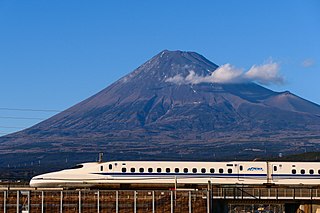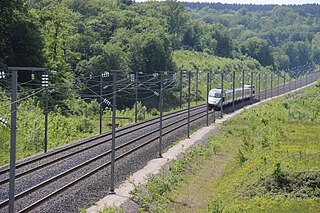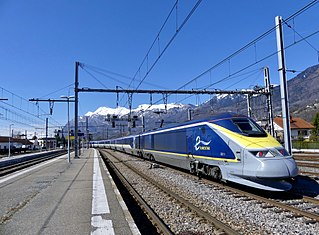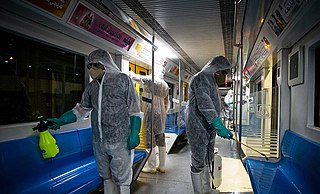This article needs to be updated.(April 2016) |
| Years in rail transport |
|---|
| Timeline of railway history |
This article lists events related to rail transport that occurred in 2015.
This article needs to be updated.(April 2016) |
| Years in rail transport |
|---|
| Timeline of railway history |
This article lists events related to rail transport that occurred in 2015.
This section has multiple issues. Please help improve it or discuss these issues on the talk page . (Learn how and when to remove these template messages)
|

High-speed rail (HSR) is a type of rail transport network utilizing trains that run significantly faster than those of traditional rail, using an integrated system of specialized rolling stock and dedicated tracks. While there is no single standard that applies worldwide, lines built to handle speeds above 250 km/h (155 mph) or upgraded lines in excess of 200 km/h (125 mph) are widely considered to be high-speed.

The TGV is France's intercity high-speed rail service, operated mainly by SNCF. SNCF worked on a high-speed rail network from 1966 to 1974 and presented the project to President Georges Pompidou who approved it. Originally designed as turbotrains to be powered by gas turbines, TGV prototypes evolved into electric trains with the 1973 oil crisis. In 1976 the SNCF ordered 87 high-speed trains from Alstom. Following the inaugural service between Paris and Lyon in 1981 on the LGV Sud-Est, the network, centered on Paris, has expanded to connect major cities across France and in neighbouring countries on a combination of high-speed and conventional lines. The TGV network in France carries about 110 million passengers a year.

Pakistan Railways is the national, state-owned railway company of Pakistan with its headquarters in Lahore. Founded in 1861 as the North Western State Railway and headquartered in Lahore, it owns 7,789 kilometres of operational track across Pakistan, stretching from Peshawar to Karachi, offering both freight and passenger services, covering 488 operational stations across Pakistan.

The Ligne à Grande Vitesse Nord, typically shortened to LGV Nord, is a French 333-kilometre (207 mi)-long high-speed rail line, opened in 1993, that connects Paris to the Belgian border and the Channel Tunnel via Lille.

The Ligne à Grande Vitesse Est européenne, typically shortened to LGV Est, is a French high-speed rail line that connects Vaires-sur-Marne and Vendenheim. The line halved the travel time between Paris and Strasbourg and provides fast services between Paris and the principal cities of Eastern France as well as Luxembourg and Germany. The LGV Est is a segment of the Main Line for Europe project to connect Paris with Budapest with high-speed rail service.

The period from 1995 covers the history of rail transport in Great Britain following the privatisation of British Rail. During this period, passenger volumes have grown rapidly, safety has improved, and subsidies per journey have fallen. However, there is debate as to whether this is due to privatisation or to better government regulation. During this period, High Speed 1, the West Coast Main Line upgrade and Crossrail were completed and more construction projects are currently under way. The period also saw the demise of privately-owned Railtrack and its replacement with government-owned Network Rail.

The Perpignan–Barcelona high-speed line is an international high-speed rail line between Perpignan in Roussillon, France and Barcelona, Spain. The line consists of a 175.5-kilometre (109.1 mi) railway, of which 24.6 km (15.3 mi) are in France and 150.8 km (93.7 mi) are in Spain. The line is sometimes referenced as an extension of the Madrid–Barcelona high-speed rail line. The Perpignan–Barcelona line is a part of the Mediterranean Corridor.

The Wuhan–Guangzhou high-speed railway, also called the Wuguang high-speed railway and short for Beijing–Guangzhou–Shenzhen–Hong Kong high-speed railway, Wuhan–Guangzhou section, is a 968-kilometre (601 mi) high-speed rail line, operated by China Railway High-speed (CRH), connecting Wuhan and Guangzhou, the provincial capitals of Hubei and Guangdong, respectively. It was the world's fastest train service, initially using coupled CRH2C and CRH3C trains which averages 313 km/h (194 mph) in non-stop commercial service.

The British Rail Class 373, known in France as the TGV TMST and branded by Eurostar as the Eurostar e300, is a French designed and Anglo-French built electric multiple unit train that was used for Eurostar international high-speed rail services from the United Kingdom to France and Belgium through the Channel Tunnel. Part of the TGV family, it was built with a smaller cross-section to fit the smaller loading gauge in Britain, was originally capable of operating on the UK third rail network, and has extensive fireproofing in case of fire in the tunnel. It is both the second longest—387 metres —and second fastest train in regular UK passenger service, operating at speeds of up to 300 kilometres per hour (186 mph).

On 14 November 2015, a TGV train derailed in Eckwersheim, Alsace, France, while performing commissioning trials on the second phase of the LGV Est high-speed rail line, which was scheduled to open for commercial service five months later. The derailment resulted in 11 deaths and 42 injuries. It was the first fatal derailment in the history of the TGV and the third derailment since the TGV entered commercial service in 1981.

Passenger rail ridership plummeted worldwide amid the COVID-19 pandemic; many services were reduced in frequency or discontinued outright.